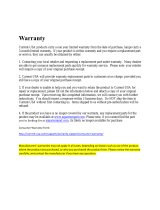Page is loading ...

Getting started
1. Packing list
2. Initial setup
3. Specification
Enjoying photos
1. Viewing photos
2. Copying photos
3. Viewing photo slideshows
4. Deleting and Rotating photos
Optimizing Photo Display
1. Selecting brightness, languages and set time functions
2. Checking Photo Display status
3. Taking care of your Photo Display
Getting help
1. Frequently asked questions
2. Troubleshooting
3. Service and Warranty
Appendix
1. Philips Pixel Defect Policy
2. Regulatory
file:///D|/EDFU/Digital_photo_Display/edoc/PhotoDisplay/english/temp_Index.htm2005-10-03 04:45:45

Packing List
•
Packing list
•
Initial setup
•
Specification
Getting started
Packing List
Digital Photo Display Photo display Stand
Quick start guide User manual CD
Power adaptor
USB cable to Digital Camera
(female A type plug)
USB Cable to PC
(male A type plug)
What else you'll need
file:///D|/EDFU/Digital_photo_Display/edoc/PhotoDisplay/english/a1_pack.htm (1 of 2)2005-10-03 04:45:53

Packing List
Power outlet Digital Photos on camera, memory card or PC
RETURN TO TOP OF THE PAGE
©2005 Koninklijke Philips Electronics NV
All rights reserved. Reproduction, copying, use, modification, hiring, renting, public performance,
transmission and/or broadcasting in whole or in part is prohibited without written consent of Philips
Electronics NV
file:///D|/EDFU/Digital_photo_Display/edoc/PhotoDisplay/english/a1_pack.htm (2 of 2)2005-10-03 04:45:53

Initial setup
•
Packing list
•
Initial setup
•
Specification
Getting started
Initial setup
Philips digital photo display can be placed either vertically or horizontally to fit the
photos on display. Its internal rechargeable battery provides you the freedom to pass
it around and show photos without the power cord. Or, you can place it somewhere in
the room for constant photo display by connecting it to the main.
A. Removing the protective bag/film on parts
B. Attaching the Photo Display stand
•
Place head of stand into socket
•
Rotate clockwise until stand locks in-place
C. Connecting to a power source
•
Connect the supplied power cable from Photo Display to a power outlet .
The internal battery will start charging and the battery LED turn orange.
file:///D|/EDFU/Digital_photo_Display/edoc/PhotoDisplay/english/a2_initial.htm (1 of 3)2005-10-03 04:45:55

Initial setup
Locate control keys
•
Use your photo display by pressing the control keys in the back.
•
LCD display also shows the function icon for each key at the same position.
Previous/Left Switch view Setup
Next/ Right Show/ Hide icon Photo setting
Up Copy Confirm
Down Delete Escape
C. Turning on Photo Display
•
Slide the power switch up to the ON position.
The power LED will be green and the Startup screen will appear.
file:///D|/EDFU/Digital_photo_Display/edoc/PhotoDisplay/english/a2_initial.htm (2 of 3)2005-10-03 04:45:55

Initial setup
D. Choose your preferred language
•
Press the key (the 3
rd
key from the left on the rear of Photo Display)
A menu with general settings for Photo Display will appear.
•
Use the or key to highlight Language and press the key to select.
•
Use the or key to choose your preferred language. Press to confirm your
selection. The new setting will be effective immediately.
•
Press again to leave the Language menu.
RETURN TO TOP OF THE PAGE
file:///D|/EDFU/Digital_photo_Display/edoc/PhotoDisplay/english/a2_initial.htm (3 of 3)2005-10-03 04:45:55

Specification
•
Packing list
•
Initial setup
•
Specification
Getting started
Specification
Picture/Display
-
Effective display area: 137 x 91 mm (5.4" x 3.6"), 6.5" diagonal
-
Vertical dot pitch: 0.1905 mm
-
Horizontal dot pitch: 0.1905 mm
-
Resolution: 720 x 480 pixels
-
Brightness: 200 nits
-
Viewing angle (CR>5): Horizontal (-85°~85°), Vertical (-85°~85°)
-
Backlight Half-Life time: 20,000 hours
Connectivity
-
Card reader: Built-in Secure digital (SD), Multimedia card (MMC), Memory stick
(MS, MS Pro), Compact flash (CF) type I only.
Convenience
Photo format supported: Up to 12M pixels, JPEG photos following EXIF and DCF
standards
Memory size: 50 photos or more
Placement supported: Landscape, Portrait
Control buttons: 6 buttons
Display mode Automatic slideshow, Full-Screen browse, Thumbnail browse
Setup menu:
file:///D|/EDFU/Digital_photo_Display/edoc/PhotoDisplay/english/a3_spec.htm (1 of 4)2005-10-03 04:45:55

Specification
file:///D|/EDFU/Digital_photo_Display/edoc/PhotoDisplay/english/a3_spec.htm (2 of 4)2005-10-03 04:45:55

Specification
Photo menu:
OSD languages: English, French, German, Italian, Spanish, Simplified Chinese,
Russian, Japanese
Plug & Play compatibility: Windows 2000/XP or later, Mac OS X or later, Linux
Accessories
-
Included accessories: AC power adaptor, USB cables, Quick start guide
-
User manual: Yes (in CD-ROM)
Power
-
Power LED indicator Green (power on), Off (power off)
-
Battery LED indicator Orange (charging), Off (not charging)
-
Power mode supported Battery powered, AC powered
RETURN TO TOP OF THE PAGE
file:///D|/EDFU/Digital_photo_Display/edoc/PhotoDisplay/english/a3_spec.htm (3 of 4)2005-10-03 04:45:55

Specification
file:///D|/EDFU/Digital_photo_Display/edoc/PhotoDisplay/english/a3_spec.htm (4 of 4)2005-10-03 04:45:55

Viewing Photos
•
Viewing photos
•
Copying photos
•
Viewing photo slideshows
•
Deleting and Rotating
photos
Enjoying photos
Viewing Photos
When there is no memory card in photo display, and neither a digital camera is connected
to photo display, it displays photos stored in local memory. When a memory card is
inserted or digital camera is actively connected to Photo Display, it will display photos
from most recently connected media or device in a "Last-in, First-display" order.
You can choose from three Photo Display viewing modes. Press ( the 1
st
key
from the left on the rear of Photo Display) to toggle among the three viewing
modes; use
to view the previous photo and to view the next photo.
(
and are the first two keys from the right on the rear of Photo Display.)
THUMBNAIL-List of photos.
file:///D|/EDFU/Digital_photo_Display/edoc/PhotoDisplay/english/b1_view.htm (1 of 6)2005-10-03 04:45:57

Viewing Photos
A
Each icon represents the function of the corresponding
key in the rear of Photo Display.
B Source of photos on screen
Camera Compact flash Memory stick
SD, MMC Photo Display
C Current Photo
D Current Photo number
E
Slideshow icon
(If shown, this photo will be shown in slideshow.)
F Current photo number, same as D
G Total photo count
H Resolution of current photo (in pixels).
I Date current photo was taken
J Source of displayed photos.
SLIDESHOW- Automatic, Rotating display of photos.
file:///D|/EDFU/Digital_photo_Display/edoc/PhotoDisplay/english/b1_view.htm (2 of 6)2005-10-03 04:45:57

Viewing Photos
BROWSE—Manual viewing of photos one-by-one. (Displays size and date)
Each icon represents the function of the corresponding key in the rear of Photo Display.
A
Each icon represents the function of the corresponding
key in the rear of Photo Display.
B Source of photos on screen
Camera Compact flash Memory stick
SD, MMC Photo Display
C Current Photo number
file:///D|/EDFU/Digital_photo_Display/edoc/PhotoDisplay/english/b1_view.htm (3 of 6)2005-10-03 04:45:57

Viewing Photos
D Total photo count
E Resolution of current photo (in pixels)
F Date current photo was taken
RETURN TO TOP OF THE PAGE
Viewing photos on Photo Display
•
Remove any memory card or digital camera connection from photo Display.
Photos stored in the Photo Display will appear.
Viewing digital camera photos from a memory card
•
Insert the memory card into the slot in the frame:
•
For Compact Flash card, firmly slide card in the larger slot end first and face DOWN.
•
For SD, MMC, or Memory Stick card, slide card in the smaller slot end first and face UP
until it locks in-place.
After a few seconds photos on the memory card will display.
How to remove a memory card:
•
To remove Compact Flash card, pull out the card slowly.
•
To remove SD, MMC, or Memory Stick card, push the card again to unlock and then pull
out the card.
Viewing PC photos from a memory card
(NOTE: Only support PC photos in JPEG format.)
•
Connect your memory card to your PC
(Some Notebook PCs have memory card slot built-in or you may need a separate
memory card reader to connect your memory card to PC.)
•
Make sure the memory card is empty. Remove photos stored in \DCIM\ subdirectories
of this memory card, if any.
(If there are photos in \DCIM\ subdirectories of your memory card, Photo Display may
only display these photos)
•
Copy your PC photos onto the root directory of the memory card.
(The root directory is simply represented as “\” on the memory card)
•
Safely remove your memory card from PC
•
Make sure Photo Display is ON.
•
Insert the memory card into Photo Display
file:///D|/EDFU/Digital_photo_Display/edoc/PhotoDisplay/english/b1_view.htm (4 of 6)2005-10-03 04:45:57

Viewing Photos
(If you turn on Photo Display after memory card is inserted, the photos in the root
directory will be copied to Photo Display automatically.)
•
After a few seconds photos in the root directory of your memory card will appear.
A CF Card
B SD/ MMC/MS Card
Viewing photos from a digital camera
•
Connect the supplied USB cable to Digital Camera to Photo Display.
•
Connect your digital camera to the USB cable that came with the camera.
•
Connect the two USB cables and switch on camera in play mode.
(Note: Some cameras do not support direct playback)
After a few seconds photos on your digital camera will appear.
A
Supplied USB cable to Digital Camera
(female A type plug)
file:///D|/EDFU/Digital_photo_Display/edoc/PhotoDisplay/english/b1_view.htm (5 of 6)2005-10-03 04:45:57

Copying Photos
•
Viewing photos
•
Copying photos
•
Viewing photo slideshows
•
Deleting and Rotating
photos
Enjoying photos
Copying Photos
You can copy photos stored on a memory card, digital camera or PC to Photo Display.
Photo Display will then internally store a resized copy of the original photo. This resized
copy will remain inside Photo Display until you delete it from Photo Display.
Photo Display's internal memory will store 50 or more resized photos. Please see the
Deleting and Rotating Photos section to learn how to delete photos stored in Photo
Display.
Copying from a digital camera or a memory card
You may copy photos one by one in Browse mode or several photos at once in Thumbnail
mode.
Copying photo one by one in Browse mode
•
Change view mode to Browse.
•
Connect the digital camera or insert the memory card into Photo Display.
Photos from digital camera or memory card will appear.
Note: Some cameras do not support direct playback. Please use memory card instead in
such cases.
•
With the photo for copy shown on screen, press the key (the 4
th
key from the left on
the rear of Photo Display). Four different orientations of the selected photo will appear.
file:///D|/EDFU/Digital_photo_Display/edoc/PhotoDisplay/english/b2_copy.htm (1 of 6)2005-10-03 04:45:58

Copying Photos
•
Use the or key to select the desired photo orientation and then press the
key.
Do not remove the memory card or disconnect the camera before the copy screen
disappears upon completion.
If a warning message shows up indicating no free space for more photos, you may need
to remove some already stored photos first before copying more photos.
•
After the copy screen disappears upon completion, a resized copy of the photo is stored
inside Photo Display.
•
You may move to other photos and continue this process until all the photos you want
are copied to Photos Display.
Copy several photos at once in Thumbnail mode
•
Change view mode to Thumbnail.
•
Connect the digital camera or insert the memory card into Photo Display.
Photos from digital camera or memory card will appear.
Note: Some cameras do not support direct playback. Please use memory card instead in
such cases.
•
Highlight the photo for copy in Thumbnail mode and press the key (the 4
th
key from
the left on the rear of Photo Display).
A multi-photo copy screen with small photos from current thumbnail screen will appear.
file:///D|/EDFU/Digital_photo_Display/edoc/PhotoDisplay/english/b2_copy.htm (2 of 6)2005-10-03 04:45:58

Copying Photos
•
Use the or key to move, to add photos to copy list, to remove photos
from copy list, and then press the to confirm the copy list.
Photos on the copy list are shown with a small copy icon
.
Do not remove the memory card or disconnect the camera before the copy screen
disappears upon completion.
If a warning message shows up indicating no free space for more photos, you may need
to remove some already stored photos first before copying more photos.
•
You may move to other Thumbnail pages and continue this process until all the photos
you want are copied to Photo Display.
Automatically copying PC Photos to Photo Display with memory card
(recommended)
NOTE: Only support PC photos in JPEG format.
•
Connect your memory card to your PC.
(Some Notebook PCs have memory card slot built-in or you may need a separate
memory card reader to connect your memory card to PC.)
•
Copy your PC photos onto the root directory of the memory card.
(The root directory is simply represented as “\” on the memory card)
•
Safely remove your memory card from PC.
•
Make sure Photo Display is OFF.
•
Insert the memory card into Photo Display.
•
Turn on Photo Display.
•
After a few seconds, all photos in root directory of your memory card will be
automatically added to Photo Display. Photos in the root directory will stay intact after
copying.
Copying from/to PC directly
Requirements for a Windows system:
-Windows 2000/XP or later
Requirements for a Mac System:
-Mac OS X or later
•
Connect the supplied PC USB cable to Photo Display.
•
Connect the PC USB cable plug to the PC.
•
PC will then recognize Photo Display as a mass storage device. (like a camera)
file:///D|/EDFU/Digital_photo_Display/edoc/PhotoDisplay/english/b2_copy.htm (3 of 6)2005-10-03 04:45:58

Copying Photos
To copy from PC to Photo Display
•
Select photos to be transferred to Photo Display and copy these photos directly under
the root directory of Photo Display.
NOTE: Only JPEG format photos are supported. Sub-directories are not supported.
The number of photos accepted in this directory may be limited due to limited internal
memory on Photo Display. Therefore, it is highly recommended to put the photos on a
memory card and copy the photos to Photo display from that memory card.
•
Disconnect the USB cable.
For Windows 2000 systems, remember to safely remove hardware before disconnection
After a few seconds, all photos in the the root directory will be automatically added to
Photo Display and the the root directory will be emptied.
To copy from Photo Display to PC
•
Copy the photos on Photo Display to PC the same way you transfer the contents of a
digital camera to PC. All photos are stored in the sub-directories of the \DCIM\on the
Photo Display drive.
file:///D|/EDFU/Digital_photo_Display/edoc/PhotoDisplay/english/b2_copy.htm (4 of 6)2005-10-03 04:45:58
/




